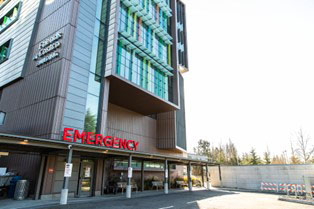Provider News
Viral Illness Trends and Emergency Department and Hospital Volumes
March 6, 2024

- ED Volumes: Our ED volumes have been stable over the last several weeks.
- Influenza: Locally, influenza levels are moderate and stable. Nationally, declines have paused and levels remain elevated, driven largely by the pediatric population. However, there is a great deal of variability from region to region.
- RSV: Activity is past peak but continues to persist at low-moderate levels.
- SARS-CoV-2: Locally, activity remains elevated but stable. JN.1 variant has completed its journey toward complete domination of the US. The US is now monitoring a new mutation, BA.2.87.1. This variant has more than 30 changes in the spike protein when compared to XBB.1.5.
- Other Respiratory Viruses: Other viruses remain stable.
- Measles: Thank you for continuing to watch for measles. Outbreaks continue across the globe and across the US.
- Norovirus: Norovirus activity remains high. This is typical for this time of the year. Norovirus usually peaks in late winter.
How You Can Help
Please continue to identify and manage lower-acuity complaints in outpatient settings, including urgent care, to help maintain ED capacity for higher-acuity concerns.
- Utilize our Healthcare Professionals site for Resources for Community Providers, including our Asthma algorithm, Bronchiolitis guidance document, COVID-19 Return to Sports algorithm, Acute Pharyngitis and Recurrent Pharyngitis.
- Advise patient families to utilize our library of Barton Schmitt patient education handouts on hundreds of conditions including COVID-19, influenza and RSV.
- Before sending your patient to the ED, contact our Mission Control team with as much notice as possible at 206-987-8899. This helps us plan for your patient’s arrival. In appropriate instances, we may be able to directly admit your patient to the hospital or arrange an urgent ambulatory clinic visit in lieu of an ED visit.
- Please be aware that our inpatient PBMU has limited capacity for new patients. At this time, we are referring pediatric patients requiring psychiatric inpatient admission to appropriate facilities in Washington state, as needed.
- Help set realistic expectations about an ED visit for mental health and/or inpatient psychiatric admission with children, families, and partners.
- An ED visit for mental or behavioral health typically involves an evaluation to determine if the child needs an inpatient psychiatric admission or is appropriate to discharge home. Patients and families should be prepared for potentially longer wait times.
- Inpatient psychiatric capacity for pediatrics remains limited at Seattle Children’s and across Washington; we are asking all external partners to consider referring patients who need inpatient admission to all appropriate inpatient pediatric psychiatric facilities in Washington and consistently re-assess need for inpatient admission.
- An inpatient psychiatric admission is typically 5 to 10 days and focused on acute crisis stabilization. It is not a long-term placement.